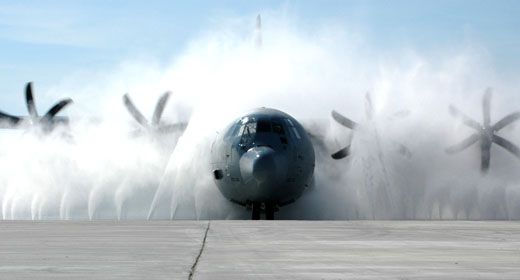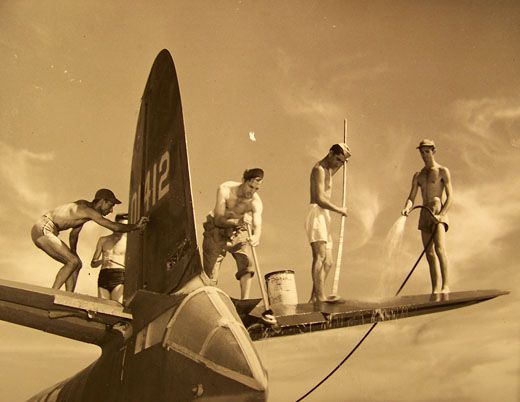Then & Now: Wash Day
Then & Now: Wash Day
/https://tf-cmsv2-smithsonianmag-media.s3.amazonaws.com/filer/ON08_TandN_Main_388x247.jpg)
For decades, the U.S. Air Force had no standard approach for washing its airplanes. Crews would simply scrub off the grime with hoses and whatever was at hand—mops, rags, sponges, or squirt bottles. But all the grease and fluids would run off with the washwater, making a big mess. Toxic chemicals like benzene, chromium, or mercury, along with the solvents used to remove them, sometimes soaked into the ground or drained into nearby waterways.
One of the earliest documented aircraft wash racks—a structure similar to a drive-through car wash—was built in 1953 at Carswell Air Force Base in Fort Worth, Texas. There the problem was wastewater washing into a storm drain system that emptied into the Trinity River. So Carswell borrowed a portable flotation unit to corral the wastewater until a permanent treatment plant was built.
Federal environmental laws of the 1970s put bases under tight restrictions to catch the runoff on wash day. At bases near saltwater, like Mississippi’s Keesler and Florida’s Homestead, aircraft taxi through a special ramp hose system with drains to collect and recycle the water. The airplanes are rinsed after each flight, and get a full wash every 30 days.
At McChord Air Force Base in Washington state, aircraft are washed in one of three hangars, two of which are big enough to accommodate the giant C-17 Globemaster III transport. The hangar floors are sloped slightly, with three trenches to collect the water. Pressure-washing a C-17 takes eight workers about 12 hours and 500 to 700 gallons of water. Each worker wears a face shield and apron to guard against harsh solvents and uses a three-foot-long washer wand.
“We do 30 major washes a month and maybe 100 minor washes,” says McChord quality assurance manager John Bobincheck. The base also fills requests to clean C-130 Hercules transports, KC-135 Stratotankers, and Army CH-47 Chinook helicopters. Wheel wells get the grimiest; bird strikes leave the most gunk.
A thorough cleaning involves doing the interior as well, and by hand. “The best way to describe a dirty transport aircraft is if you’ve taken your kids across country by car,” says Bobincheck. “There’s candy wrappers and box lunches and foam earplugs and general dirt and debris. If we’re loading vehicles, they have to go up a ramp and that will often knock whatever’s on the vehicle loose into the underfloor [a metal gridwork to tie down cargo]. You pressure-wash and then vacuum up the excess water.”
Some bases filter their washwater and discharge it into the local sewer system, while others recycle and reuse it. Both methods are covered by the guidelines in a 360-page Air Force technical order issued in 2003 that specifies every scour pad, solvent, and means of disposal involved in washing aircraft, categorized by Air Force base.
It also provides recommendations on how often to wash the airplanes. Those in areas susceptible to corrosive saltwater get a mandatory once-a-month scrub, but airplanes at the vast majority of bases—including those in Afghanistan and Iraq—can go quite a big longer between washes, up to six months. But the bathing is not about vanity; the washes keep corrosion at bay and help ensure that every aircraft stays airworthy.

